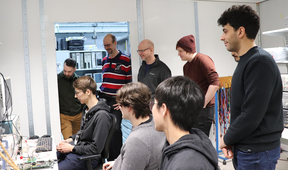Aalto University students combine an open microprocessor with an AI accelerator

In summer 2021, a group of Aalto University microelectronics students implemented a hardware description of a RISC-V microprocessor and made it freely available online. Now, an AI accelerator and encryption accelerator have been added to the open microprocessor coded by Aalto students. The processor chip has been sent for manufacturing and is expected to arrive for testing and measurements in spring 2023.
The goal of the processor project is to foster processor design expertise in Finland when the accelerating global growth of the microelectronics industry and the investments have created increasing demand for experts in the field. The field of microelectronics encompasses many applications of electronics, such as microprocessors, which are currently used in ubiquitously in our daily lives, from remote controls to cars and aeroplanes.
The processor currently in production was designed from the ground up by students in Otaniemi. The students designed the processor in its entirety, starting from its instruction set. An instruction set is a technical document that defines how the microprocessor should respond to instructions passed to it. Later in the spring, the project group will be able to measure how well their processor chip operates.
‘Our goal is to ensure that future microelectronics specialists will be able to utilise their RISC-V expertise in corporate settings as well. This project has helped us refine our teaching, and we have also noticed a definite uptick in student interest in the field,’ notes Professor of Microelectronics design Jussi Ryynänen from Aalto University.
‘We started the implementation process from the processor’s instruction set so that our students could learn how to create processors, as the processors are way more difficult to design than to use. We are also striving to utilize programming more in our microelectronics design process, and processor design is well suited to this goal. This project has helped our students realise that programming can be used to create more than just software. Additionally, we can utilize of A-Core, our processor, in some of our courses, to strengthen our expertise at the software–hardware interface,’ explains Senior University Lecturer Marko Kosunen.
AI and encryption demand computational speed
The implemented AI accelerator is able to accelerate general vector-matrix multiplications at a considerably faster rate than any software-based solutions. Vector-matrix multiplications represent the basic foundation of many AI applications, and the hardware accelerator aims to optimise and accelerate the execution of these operations. This goal is also supported by an encryption algorithm-oriented computational accelerator, which can be used to, for example, encrypt communications.
The project is conducted collaboratively with companies participating in Business Finland’s Veturi programme: Nokia, Saab, CoreHW and Xiphera. In addition to Ryynänen and Kosunen, the participating students at Aalto University are guided by Assistant Professor Martin Andraud. The project has involved around twenty students in total, and it has resulted in several bachelor’s and master’s theses as well as the recent initiation of a doctoral dissertation on the processor and its development.
Kosunen emphasises that AI applications can involve dozens and even hundreds of cores. The advantage of this open processor is its adaptability, and it has allowed even Aalto’s A-Core processor to operate in a wide range of environments.
The RISC-V instruction set coded by Aalto students is open, accessible to everyone and designed to be modifiable and expandable for any need. A-Core can be downloaded from Gitlab, an open source platform, at this address: https://gitlab.com/a-core

Students coded an open-source microprocessor that companies can use as they wish
The new processor is suitable, for example, for 6G transceivers and encryption technology. The project encourages young people to study microelectronics; skills that are in high demand in Finland.

Read more news

Aalto Mac: Network settings to be updated
Updates begin during Christmas time
Research Council of Finland establishes a Center of Excellence in Quantum Materials
The Centre, called QMAT, creates new materials to power the quantum technology of coming decades.
Two Unite! Seed Fund projects involving Aalto secure top EU funding
Two prestigious EU grants have been awarded to projects that were initially supported with Unite! Seed Funding. Both projects involve Aalto.






